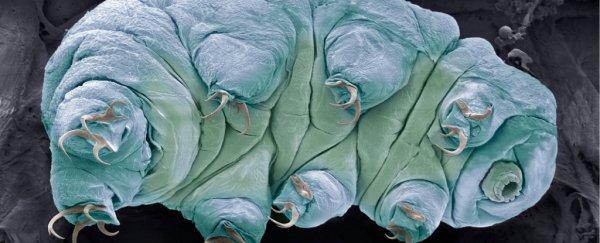Humans wouldn't survive two minutes in space, but in 2007, two species of tardigrades were released into space and then collected again - still alive.
Tardigrades are a group of tiny invertebrate species that live all over the world - you can probably find one yourself on a piece of moss in your back garden or local park. Actually, you can find them pretty much anywhere - on a mountain top, at the bottom of the sea or even in a volcano!
Astrobiologist Dr Jon Stone from McMaster University summarises how they can survive a battery of extreme conditions, including temperatures as cold as -180°C for 14 days or oven heat of 151°C for 30 minutes.
They can also survive "5000 Gy gamma radiation (which is the radiation type that, in the Marvel Universe, transformed David Banner into the Incredible Hulk). Where 5-10 Gy kills humans" says Dr Stone.
They can also survive being in a frozen state for 30 years and potentially up to 100 years, although that long is still contested writes Dr Stone.
But are tardigrades the most indestructible animals on Earth? We asked eight biologists who study them - 63 percent said "Yes" meaning there is still some debate on this question. Here's what we learned from experts.
Why are tardigrades so indestructible?
When conditions are difficult to live in, tardigrades curl up into a ball called a tun. When in a tun, the tardigrade goes into a kind of 'paused' state, called 'cryptobiosis'.
During cryptobiosis, animals don't move, grow or reproduce, but they are protected from extreme conditions. There are multiple types of cryptobiosis depending on what conditions you are dealing with.
The best-studied type is called 'anhydrobiosis', which protects from cells drying out when there is no water.
If cells dry out, lots of things can get damaged like their DNA and membranes. When some animals undergo anhydrobiosis, their cells become filled with a sugar called trehalose, which protects the cell contents until there is water again.
Anhydrobiosis in tardigrades was discovered way back in 1702, when scientist Anton von Leewenhoek dried out and revived the tardigrades he found on house roofs. Tardigrades can remain in cryptobiosis with no food or water for years, for at least 30 years if frozen.
Marine tardigrades are not indestructible
There are more than 1,400 known species of tardigrades and each differs in their ability to undergo different types of cryptobiosis. Biologist Dr William Miller From Baker University explains, "Terrestrial tardigrades in cryptobiosis are very resistant to destruction … But marine and freshwater tardigrades do not exhibit cryptobiosis, and thus are very destructible."
Similarly, only some species of tardigrades make trehalose, the sugar substance that protects cells during anhydrobiosis.
The species of tardigrades that don't make trehalose may have some other tricks to protect them from harsh conditions like special proteins that turn into a glass-like substance to protect cells. There is lots of interesting research to be done to understand this set of survival tools, but it's clear tardigrades can't all be lumped together.
Some things that can destroy a tardigrade
Generally tardigrades are way more resistant to changes in their environment than most animals. They are often studied in an astrophysical context - for example identifying whether they would survive if Earth was hit by an asteroid.
However, this doesn't mean they are indestructible against everything - as expert Dr Dennis Persson puts it, "Tardigrades are certainly one of the most stress-tolerant animals on Earth, but they are very easily destroyed with the prick of a needle, or eaten by other animals, fungi and protists."
Although tardigrades are resilient in some ways, they are vulnerable to things that most animals are in danger of, such as predators and infections.
Tardigrades vs Nematodes
Working out whether tardigrades are the most indestructible animals, we need to know about the competition. Ecologist Dr Diego Fontaneto explains that 'other animals can survive what we consider extreme conditions for life.
Among them, there are nematodes and rotifers, which share similar life-history strategies, habitats, and body size with tardigrades. These animals survive desiccation and freezing as much as tardigrades, if not even better than tardigrades.'
Other animals that have the cryptobiosis trick up their sleeves include nematode worms, some kinds of shrimp, and even some species of plants and yeast! Nematodes have been particularly well studied, and paleobiologist Dr Graham Budd notes that "The record for survival in a dehydrated state is held by the nematode Tylenchus polyhypnus at 39 years."
And the tardigrade Vs nematode battle has not been verified yet. "In general, as different animals have different survival capabilities in different conditions, it is difficult to single one type out as the 'most resilient ever'," says Dr Budd.
Takeaway: Tardigrades may be the most indestructible animal, but they are not resistant to any type of harm and many experts say Nematodes are a close challenger to this title. Despite the debate, it's certain that we are only just beginning to learn which creatures can cope in extreme environments, and how they do it.
Article based on 8 expert answers to this question: Are tardigrades the most indestructible animal on Earth?
This expert response was published in partnership with independent fact-checking platform Metafact.io. Subscribe to their weekly newsletter here.
